University Research Report: Smoking's Impact on UK Public Health
VerifiedAdded on 2023/04/20
|9
|2493
|362
Report
AI Summary
This research report investigates the impact of smoking on public health in the United Kingdom, exploring its effects on mortality rates, disease prevalence, and healthcare systems. The report analyzes statistical data, including smoking-related deaths and hospital admissions, to highlight the severity of the issue. It examines the evolution of UK government policies, including age restrictions, smoking bans in public places, and the introduction of e-cigarettes, to curb tobacco consumption and promote public awareness. The role of media, including print, digital, and social platforms, in disseminating information and influencing public attitudes towards smoking is also discussed. The report concludes by emphasizing the importance of media and policy interventions in addressing smoking as a public health concern, with the ultimate goal of reducing smoking rates and improving overall population health and well-being.
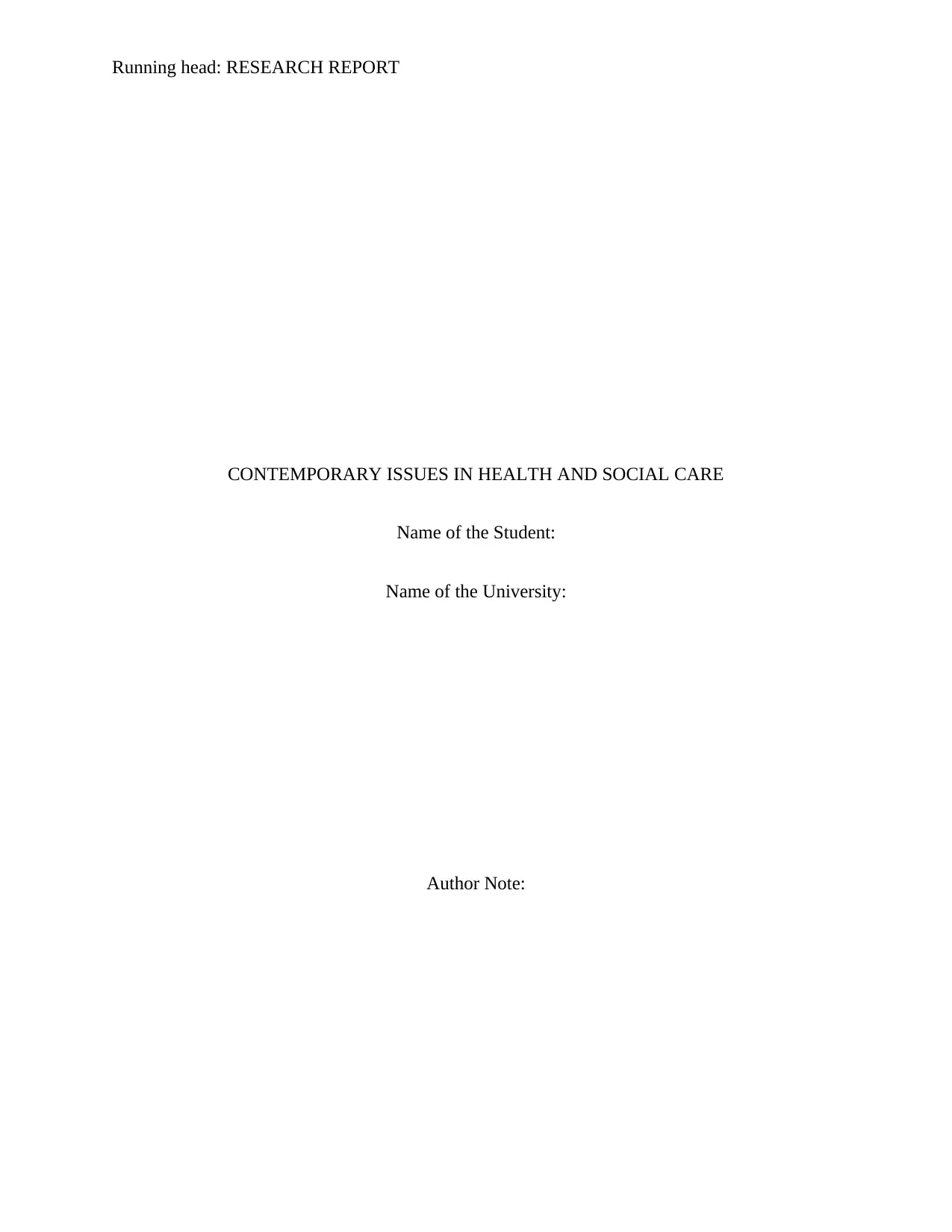
Running head: RESEARCH REPORT
CONTEMPORARY ISSUES IN HEALTH AND SOCIAL CARE
Name of the Student:
Name of the University:
Author Note:
CONTEMPORARY ISSUES IN HEALTH AND SOCIAL CARE
Name of the Student:
Name of the University:
Author Note:
Paraphrase This Document
Need a fresh take? Get an instant paraphrase of this document with our AI Paraphraser
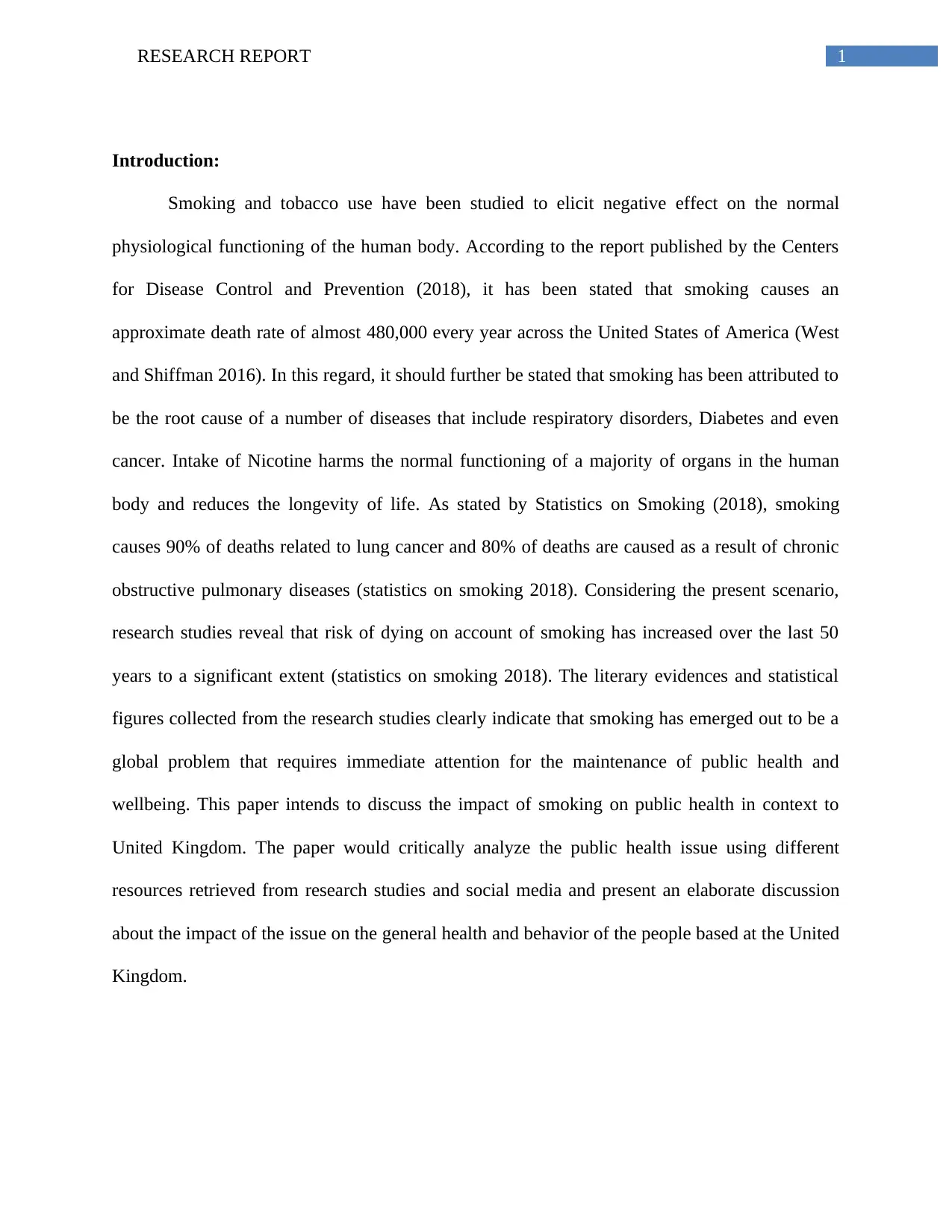
1RESEARCH REPORT
Introduction:
Smoking and tobacco use have been studied to elicit negative effect on the normal
physiological functioning of the human body. According to the report published by the Centers
for Disease Control and Prevention (2018), it has been stated that smoking causes an
approximate death rate of almost 480,000 every year across the United States of America (West
and Shiffman 2016). In this regard, it should further be stated that smoking has been attributed to
be the root cause of a number of diseases that include respiratory disorders, Diabetes and even
cancer. Intake of Nicotine harms the normal functioning of a majority of organs in the human
body and reduces the longevity of life. As stated by Statistics on Smoking (2018), smoking
causes 90% of deaths related to lung cancer and 80% of deaths are caused as a result of chronic
obstructive pulmonary diseases (statistics on smoking 2018). Considering the present scenario,
research studies reveal that risk of dying on account of smoking has increased over the last 50
years to a significant extent (statistics on smoking 2018). The literary evidences and statistical
figures collected from the research studies clearly indicate that smoking has emerged out to be a
global problem that requires immediate attention for the maintenance of public health and
wellbeing. This paper intends to discuss the impact of smoking on public health in context to
United Kingdom. The paper would critically analyze the public health issue using different
resources retrieved from research studies and social media and present an elaborate discussion
about the impact of the issue on the general health and behavior of the people based at the United
Kingdom.
Introduction:
Smoking and tobacco use have been studied to elicit negative effect on the normal
physiological functioning of the human body. According to the report published by the Centers
for Disease Control and Prevention (2018), it has been stated that smoking causes an
approximate death rate of almost 480,000 every year across the United States of America (West
and Shiffman 2016). In this regard, it should further be stated that smoking has been attributed to
be the root cause of a number of diseases that include respiratory disorders, Diabetes and even
cancer. Intake of Nicotine harms the normal functioning of a majority of organs in the human
body and reduces the longevity of life. As stated by Statistics on Smoking (2018), smoking
causes 90% of deaths related to lung cancer and 80% of deaths are caused as a result of chronic
obstructive pulmonary diseases (statistics on smoking 2018). Considering the present scenario,
research studies reveal that risk of dying on account of smoking has increased over the last 50
years to a significant extent (statistics on smoking 2018). The literary evidences and statistical
figures collected from the research studies clearly indicate that smoking has emerged out to be a
global problem that requires immediate attention for the maintenance of public health and
wellbeing. This paper intends to discuss the impact of smoking on public health in context to
United Kingdom. The paper would critically analyze the public health issue using different
resources retrieved from research studies and social media and present an elaborate discussion
about the impact of the issue on the general health and behavior of the people based at the United
Kingdom.
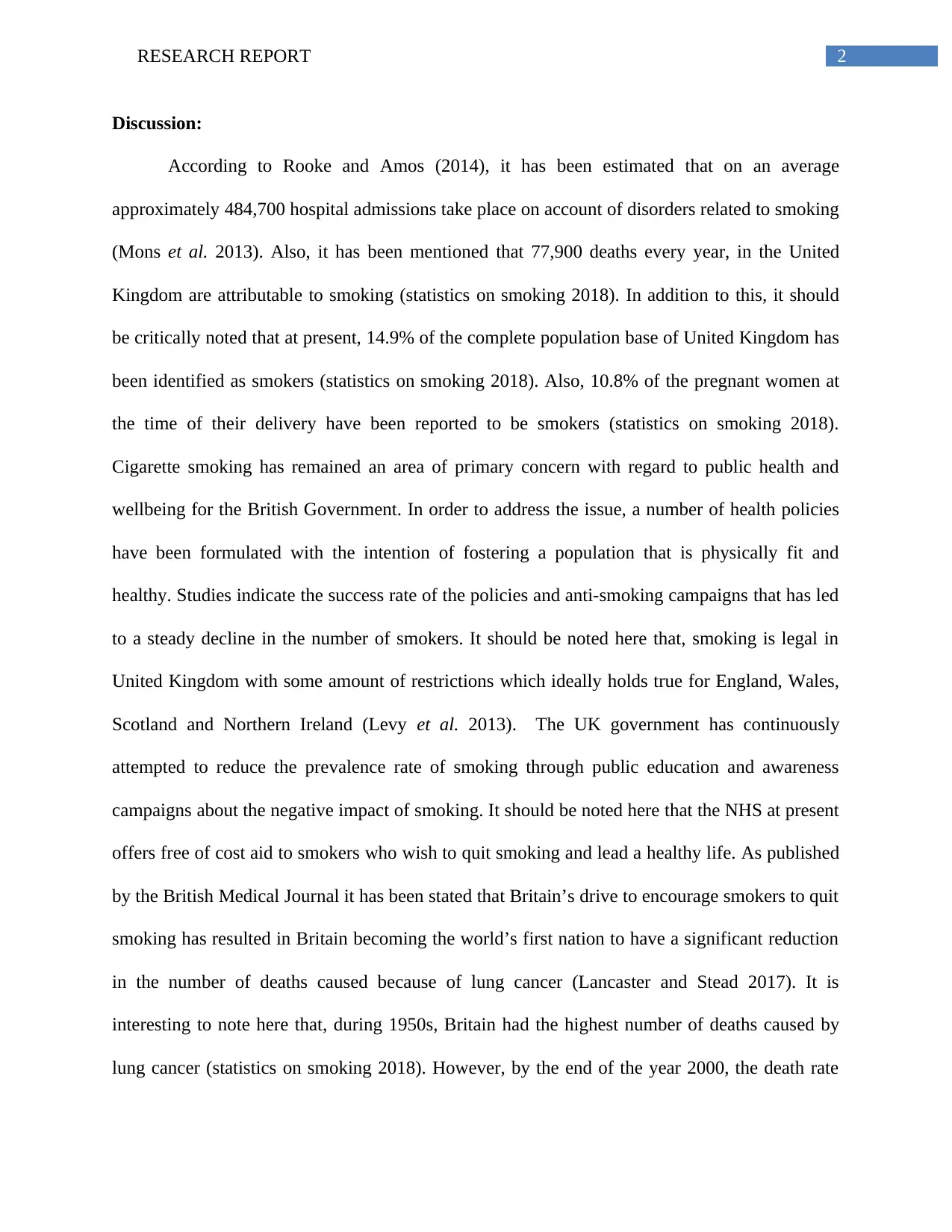
2RESEARCH REPORT
Discussion:
According to Rooke and Amos (2014), it has been estimated that on an average
approximately 484,700 hospital admissions take place on account of disorders related to smoking
(Mons et al. 2013). Also, it has been mentioned that 77,900 deaths every year, in the United
Kingdom are attributable to smoking (statistics on smoking 2018). In addition to this, it should
be critically noted that at present, 14.9% of the complete population base of United Kingdom has
been identified as smokers (statistics on smoking 2018). Also, 10.8% of the pregnant women at
the time of their delivery have been reported to be smokers (statistics on smoking 2018).
Cigarette smoking has remained an area of primary concern with regard to public health and
wellbeing for the British Government. In order to address the issue, a number of health policies
have been formulated with the intention of fostering a population that is physically fit and
healthy. Studies indicate the success rate of the policies and anti-smoking campaigns that has led
to a steady decline in the number of smokers. It should be noted here that, smoking is legal in
United Kingdom with some amount of restrictions which ideally holds true for England, Wales,
Scotland and Northern Ireland (Levy et al. 2013). The UK government has continuously
attempted to reduce the prevalence rate of smoking through public education and awareness
campaigns about the negative impact of smoking. It should be noted here that the NHS at present
offers free of cost aid to smokers who wish to quit smoking and lead a healthy life. As published
by the British Medical Journal it has been stated that Britain’s drive to encourage smokers to quit
smoking has resulted in Britain becoming the world’s first nation to have a significant reduction
in the number of deaths caused because of lung cancer (Lancaster and Stead 2017). It is
interesting to note here that, during 1950s, Britain had the highest number of deaths caused by
lung cancer (statistics on smoking 2018). However, by the end of the year 2000, the death rate
Discussion:
According to Rooke and Amos (2014), it has been estimated that on an average
approximately 484,700 hospital admissions take place on account of disorders related to smoking
(Mons et al. 2013). Also, it has been mentioned that 77,900 deaths every year, in the United
Kingdom are attributable to smoking (statistics on smoking 2018). In addition to this, it should
be critically noted that at present, 14.9% of the complete population base of United Kingdom has
been identified as smokers (statistics on smoking 2018). Also, 10.8% of the pregnant women at
the time of their delivery have been reported to be smokers (statistics on smoking 2018).
Cigarette smoking has remained an area of primary concern with regard to public health and
wellbeing for the British Government. In order to address the issue, a number of health policies
have been formulated with the intention of fostering a population that is physically fit and
healthy. Studies indicate the success rate of the policies and anti-smoking campaigns that has led
to a steady decline in the number of smokers. It should be noted here that, smoking is legal in
United Kingdom with some amount of restrictions which ideally holds true for England, Wales,
Scotland and Northern Ireland (Levy et al. 2013). The UK government has continuously
attempted to reduce the prevalence rate of smoking through public education and awareness
campaigns about the negative impact of smoking. It should be noted here that the NHS at present
offers free of cost aid to smokers who wish to quit smoking and lead a healthy life. As published
by the British Medical Journal it has been stated that Britain’s drive to encourage smokers to quit
smoking has resulted in Britain becoming the world’s first nation to have a significant reduction
in the number of deaths caused because of lung cancer (Lancaster and Stead 2017). It is
interesting to note here that, during 1950s, Britain had the highest number of deaths caused by
lung cancer (statistics on smoking 2018). However, by the end of the year 2000, the death rate
⊘ This is a preview!⊘
Do you want full access?
Subscribe today to unlock all pages.

Trusted by 1+ million students worldwide
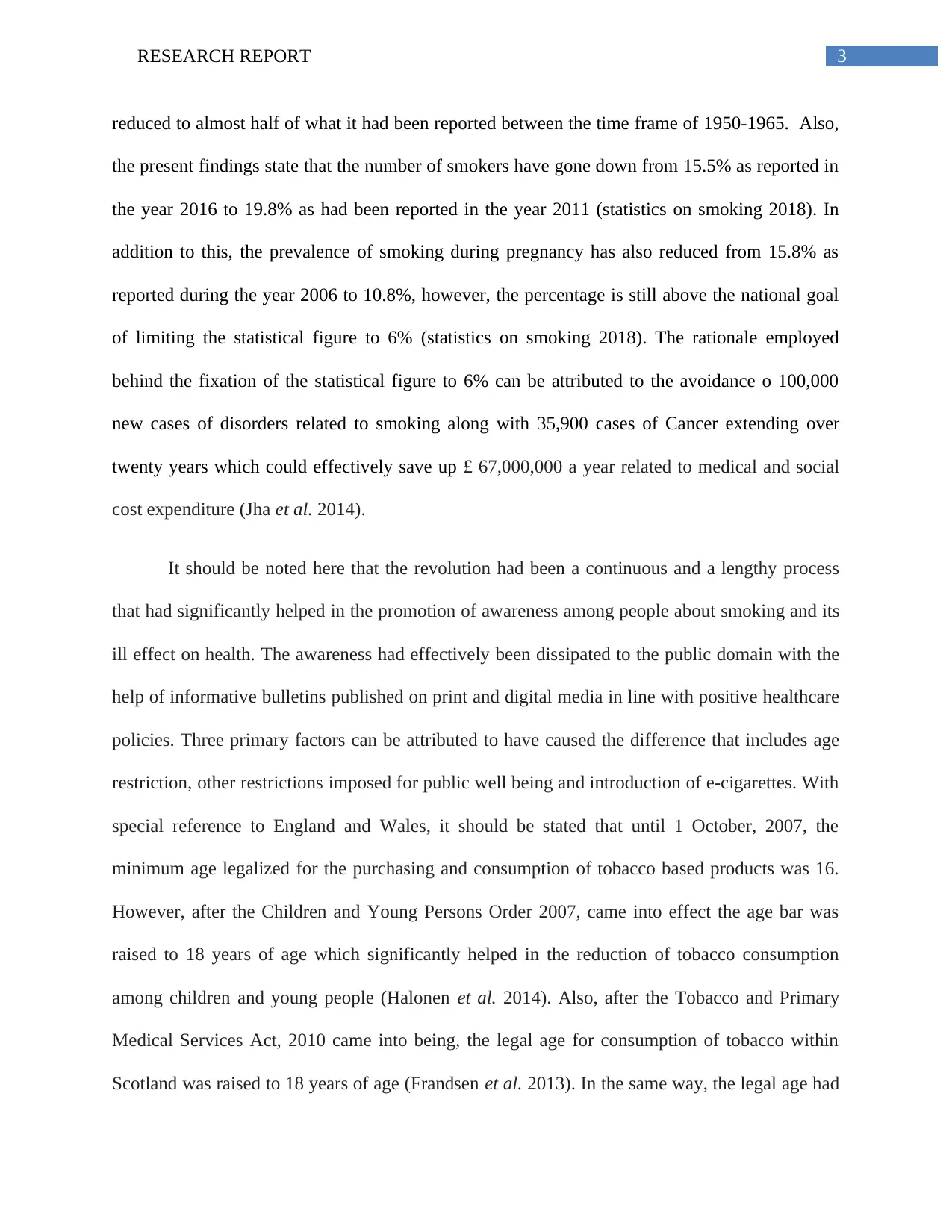
3RESEARCH REPORT
reduced to almost half of what it had been reported between the time frame of 1950-1965. Also,
the present findings state that the number of smokers have gone down from 15.5% as reported in
the year 2016 to 19.8% as had been reported in the year 2011 (statistics on smoking 2018). In
addition to this, the prevalence of smoking during pregnancy has also reduced from 15.8% as
reported during the year 2006 to 10.8%, however, the percentage is still above the national goal
of limiting the statistical figure to 6% (statistics on smoking 2018). The rationale employed
behind the fixation of the statistical figure to 6% can be attributed to the avoidance o 100,000
new cases of disorders related to smoking along with 35,900 cases of Cancer extending over
twenty years which could effectively save up £ 67,000,000 a year related to medical and social
cost expenditure (Jha et al. 2014).
It should be noted here that the revolution had been a continuous and a lengthy process
that had significantly helped in the promotion of awareness among people about smoking and its
ill effect on health. The awareness had effectively been dissipated to the public domain with the
help of informative bulletins published on print and digital media in line with positive healthcare
policies. Three primary factors can be attributed to have caused the difference that includes age
restriction, other restrictions imposed for public well being and introduction of e-cigarettes. With
special reference to England and Wales, it should be stated that until 1 October, 2007, the
minimum age legalized for the purchasing and consumption of tobacco based products was 16.
However, after the Children and Young Persons Order 2007, came into effect the age bar was
raised to 18 years of age which significantly helped in the reduction of tobacco consumption
among children and young people (Halonen et al. 2014). Also, after the Tobacco and Primary
Medical Services Act, 2010 came into being, the legal age for consumption of tobacco within
Scotland was raised to 18 years of age (Frandsen et al. 2013). In the same way, the legal age had
reduced to almost half of what it had been reported between the time frame of 1950-1965. Also,
the present findings state that the number of smokers have gone down from 15.5% as reported in
the year 2016 to 19.8% as had been reported in the year 2011 (statistics on smoking 2018). In
addition to this, the prevalence of smoking during pregnancy has also reduced from 15.8% as
reported during the year 2006 to 10.8%, however, the percentage is still above the national goal
of limiting the statistical figure to 6% (statistics on smoking 2018). The rationale employed
behind the fixation of the statistical figure to 6% can be attributed to the avoidance o 100,000
new cases of disorders related to smoking along with 35,900 cases of Cancer extending over
twenty years which could effectively save up £ 67,000,000 a year related to medical and social
cost expenditure (Jha et al. 2014).
It should be noted here that the revolution had been a continuous and a lengthy process
that had significantly helped in the promotion of awareness among people about smoking and its
ill effect on health. The awareness had effectively been dissipated to the public domain with the
help of informative bulletins published on print and digital media in line with positive healthcare
policies. Three primary factors can be attributed to have caused the difference that includes age
restriction, other restrictions imposed for public well being and introduction of e-cigarettes. With
special reference to England and Wales, it should be stated that until 1 October, 2007, the
minimum age legalized for the purchasing and consumption of tobacco based products was 16.
However, after the Children and Young Persons Order 2007, came into effect the age bar was
raised to 18 years of age which significantly helped in the reduction of tobacco consumption
among children and young people (Halonen et al. 2014). Also, after the Tobacco and Primary
Medical Services Act, 2010 came into being, the legal age for consumption of tobacco within
Scotland was raised to 18 years of age (Frandsen et al. 2013). In the same way, the legal age had
Paraphrase This Document
Need a fresh take? Get an instant paraphrase of this document with our AI Paraphraser
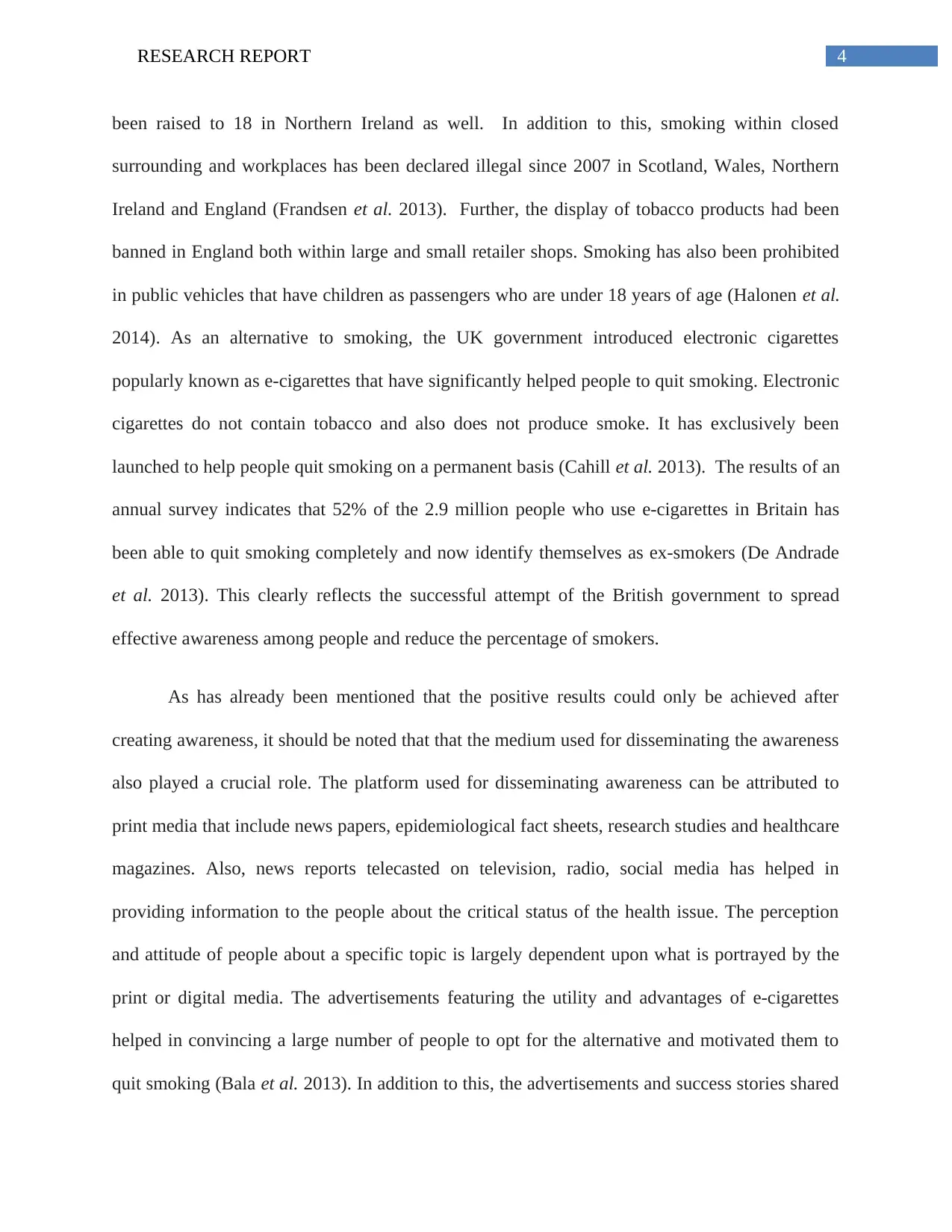
4RESEARCH REPORT
been raised to 18 in Northern Ireland as well. In addition to this, smoking within closed
surrounding and workplaces has been declared illegal since 2007 in Scotland, Wales, Northern
Ireland and England (Frandsen et al. 2013). Further, the display of tobacco products had been
banned in England both within large and small retailer shops. Smoking has also been prohibited
in public vehicles that have children as passengers who are under 18 years of age (Halonen et al.
2014). As an alternative to smoking, the UK government introduced electronic cigarettes
popularly known as e-cigarettes that have significantly helped people to quit smoking. Electronic
cigarettes do not contain tobacco and also does not produce smoke. It has exclusively been
launched to help people quit smoking on a permanent basis (Cahill et al. 2013). The results of an
annual survey indicates that 52% of the 2.9 million people who use e-cigarettes in Britain has
been able to quit smoking completely and now identify themselves as ex-smokers (De Andrade
et al. 2013). This clearly reflects the successful attempt of the British government to spread
effective awareness among people and reduce the percentage of smokers.
As has already been mentioned that the positive results could only be achieved after
creating awareness, it should be noted that that the medium used for disseminating the awareness
also played a crucial role. The platform used for disseminating awareness can be attributed to
print media that include news papers, epidemiological fact sheets, research studies and healthcare
magazines. Also, news reports telecasted on television, radio, social media has helped in
providing information to the people about the critical status of the health issue. The perception
and attitude of people about a specific topic is largely dependent upon what is portrayed by the
print or digital media. The advertisements featuring the utility and advantages of e-cigarettes
helped in convincing a large number of people to opt for the alternative and motivated them to
quit smoking (Bala et al. 2013). In addition to this, the advertisements and success stories shared
been raised to 18 in Northern Ireland as well. In addition to this, smoking within closed
surrounding and workplaces has been declared illegal since 2007 in Scotland, Wales, Northern
Ireland and England (Frandsen et al. 2013). Further, the display of tobacco products had been
banned in England both within large and small retailer shops. Smoking has also been prohibited
in public vehicles that have children as passengers who are under 18 years of age (Halonen et al.
2014). As an alternative to smoking, the UK government introduced electronic cigarettes
popularly known as e-cigarettes that have significantly helped people to quit smoking. Electronic
cigarettes do not contain tobacco and also does not produce smoke. It has exclusively been
launched to help people quit smoking on a permanent basis (Cahill et al. 2013). The results of an
annual survey indicates that 52% of the 2.9 million people who use e-cigarettes in Britain has
been able to quit smoking completely and now identify themselves as ex-smokers (De Andrade
et al. 2013). This clearly reflects the successful attempt of the British government to spread
effective awareness among people and reduce the percentage of smokers.
As has already been mentioned that the positive results could only be achieved after
creating awareness, it should be noted that that the medium used for disseminating the awareness
also played a crucial role. The platform used for disseminating awareness can be attributed to
print media that include news papers, epidemiological fact sheets, research studies and healthcare
magazines. Also, news reports telecasted on television, radio, social media has helped in
providing information to the people about the critical status of the health issue. The perception
and attitude of people about a specific topic is largely dependent upon what is portrayed by the
print or digital media. The advertisements featuring the utility and advantages of e-cigarettes
helped in convincing a large number of people to opt for the alternative and motivated them to
quit smoking (Bala et al. 2013). In addition to this, the advertisements and success stories shared
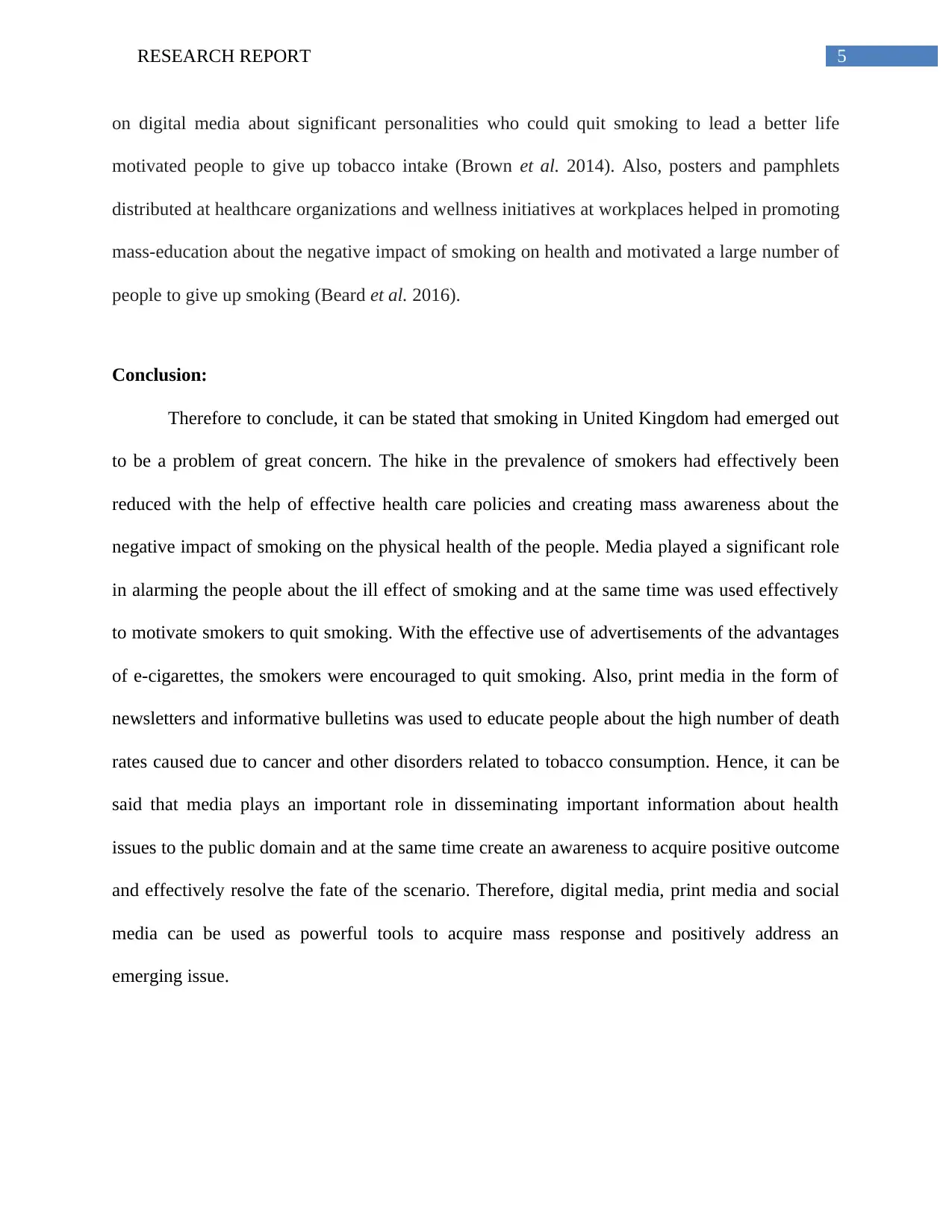
5RESEARCH REPORT
on digital media about significant personalities who could quit smoking to lead a better life
motivated people to give up tobacco intake (Brown et al. 2014). Also, posters and pamphlets
distributed at healthcare organizations and wellness initiatives at workplaces helped in promoting
mass-education about the negative impact of smoking on health and motivated a large number of
people to give up smoking (Beard et al. 2016).
Conclusion:
Therefore to conclude, it can be stated that smoking in United Kingdom had emerged out
to be a problem of great concern. The hike in the prevalence of smokers had effectively been
reduced with the help of effective health care policies and creating mass awareness about the
negative impact of smoking on the physical health of the people. Media played a significant role
in alarming the people about the ill effect of smoking and at the same time was used effectively
to motivate smokers to quit smoking. With the effective use of advertisements of the advantages
of e-cigarettes, the smokers were encouraged to quit smoking. Also, print media in the form of
newsletters and informative bulletins was used to educate people about the high number of death
rates caused due to cancer and other disorders related to tobacco consumption. Hence, it can be
said that media plays an important role in disseminating important information about health
issues to the public domain and at the same time create an awareness to acquire positive outcome
and effectively resolve the fate of the scenario. Therefore, digital media, print media and social
media can be used as powerful tools to acquire mass response and positively address an
emerging issue.
on digital media about significant personalities who could quit smoking to lead a better life
motivated people to give up tobacco intake (Brown et al. 2014). Also, posters and pamphlets
distributed at healthcare organizations and wellness initiatives at workplaces helped in promoting
mass-education about the negative impact of smoking on health and motivated a large number of
people to give up smoking (Beard et al. 2016).
Conclusion:
Therefore to conclude, it can be stated that smoking in United Kingdom had emerged out
to be a problem of great concern. The hike in the prevalence of smokers had effectively been
reduced with the help of effective health care policies and creating mass awareness about the
negative impact of smoking on the physical health of the people. Media played a significant role
in alarming the people about the ill effect of smoking and at the same time was used effectively
to motivate smokers to quit smoking. With the effective use of advertisements of the advantages
of e-cigarettes, the smokers were encouraged to quit smoking. Also, print media in the form of
newsletters and informative bulletins was used to educate people about the high number of death
rates caused due to cancer and other disorders related to tobacco consumption. Hence, it can be
said that media plays an important role in disseminating important information about health
issues to the public domain and at the same time create an awareness to acquire positive outcome
and effectively resolve the fate of the scenario. Therefore, digital media, print media and social
media can be used as powerful tools to acquire mass response and positively address an
emerging issue.
⊘ This is a preview!⊘
Do you want full access?
Subscribe today to unlock all pages.

Trusted by 1+ million students worldwide
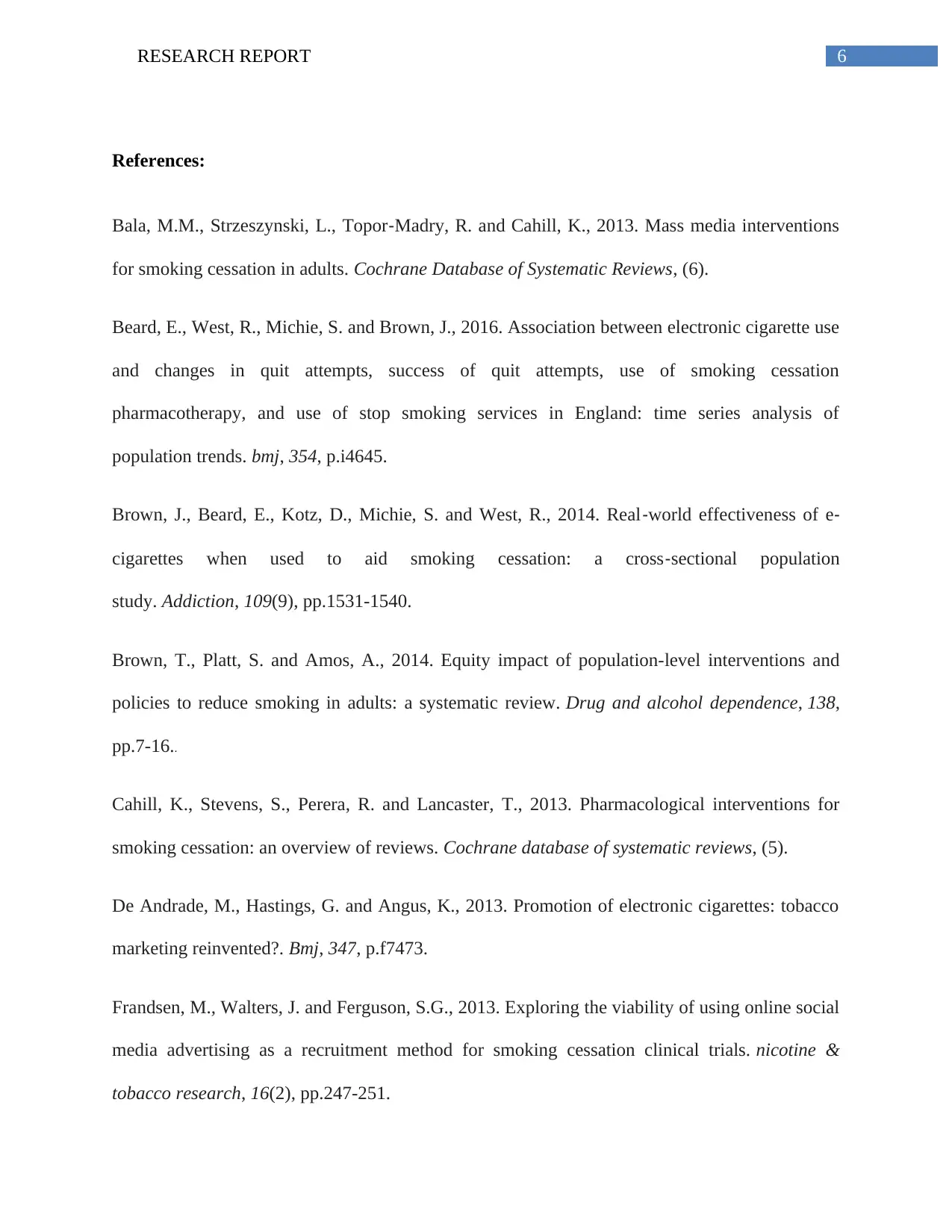
6RESEARCH REPORT
References:
Bala, M.M., Strzeszynski, L., Topor‐Madry, R. and Cahill, K., 2013. Mass media interventions
for smoking cessation in adults. Cochrane Database of Systematic Reviews, (6).
Beard, E., West, R., Michie, S. and Brown, J., 2016. Association between electronic cigarette use
and changes in quit attempts, success of quit attempts, use of smoking cessation
pharmacotherapy, and use of stop smoking services in England: time series analysis of
population trends. bmj, 354, p.i4645.
Brown, J., Beard, E., Kotz, D., Michie, S. and West, R., 2014. Real‐world effectiveness of e‐
cigarettes when used to aid smoking cessation: a cross‐sectional population
study. Addiction, 109(9), pp.1531-1540.
Brown, T., Platt, S. and Amos, A., 2014. Equity impact of population-level interventions and
policies to reduce smoking in adults: a systematic review. Drug and alcohol dependence, 138,
pp.7-16..
Cahill, K., Stevens, S., Perera, R. and Lancaster, T., 2013. Pharmacological interventions for
smoking cessation: an overview of reviews. Cochrane database of systematic reviews, (5).
De Andrade, M., Hastings, G. and Angus, K., 2013. Promotion of electronic cigarettes: tobacco
marketing reinvented?. Bmj, 347, p.f7473.
Frandsen, M., Walters, J. and Ferguson, S.G., 2013. Exploring the viability of using online social
media advertising as a recruitment method for smoking cessation clinical trials. nicotine &
tobacco research, 16(2), pp.247-251.
References:
Bala, M.M., Strzeszynski, L., Topor‐Madry, R. and Cahill, K., 2013. Mass media interventions
for smoking cessation in adults. Cochrane Database of Systematic Reviews, (6).
Beard, E., West, R., Michie, S. and Brown, J., 2016. Association between electronic cigarette use
and changes in quit attempts, success of quit attempts, use of smoking cessation
pharmacotherapy, and use of stop smoking services in England: time series analysis of
population trends. bmj, 354, p.i4645.
Brown, J., Beard, E., Kotz, D., Michie, S. and West, R., 2014. Real‐world effectiveness of e‐
cigarettes when used to aid smoking cessation: a cross‐sectional population
study. Addiction, 109(9), pp.1531-1540.
Brown, T., Platt, S. and Amos, A., 2014. Equity impact of population-level interventions and
policies to reduce smoking in adults: a systematic review. Drug and alcohol dependence, 138,
pp.7-16..
Cahill, K., Stevens, S., Perera, R. and Lancaster, T., 2013. Pharmacological interventions for
smoking cessation: an overview of reviews. Cochrane database of systematic reviews, (5).
De Andrade, M., Hastings, G. and Angus, K., 2013. Promotion of electronic cigarettes: tobacco
marketing reinvented?. Bmj, 347, p.f7473.
Frandsen, M., Walters, J. and Ferguson, S.G., 2013. Exploring the viability of using online social
media advertising as a recruitment method for smoking cessation clinical trials. nicotine &
tobacco research, 16(2), pp.247-251.
Paraphrase This Document
Need a fresh take? Get an instant paraphrase of this document with our AI Paraphraser
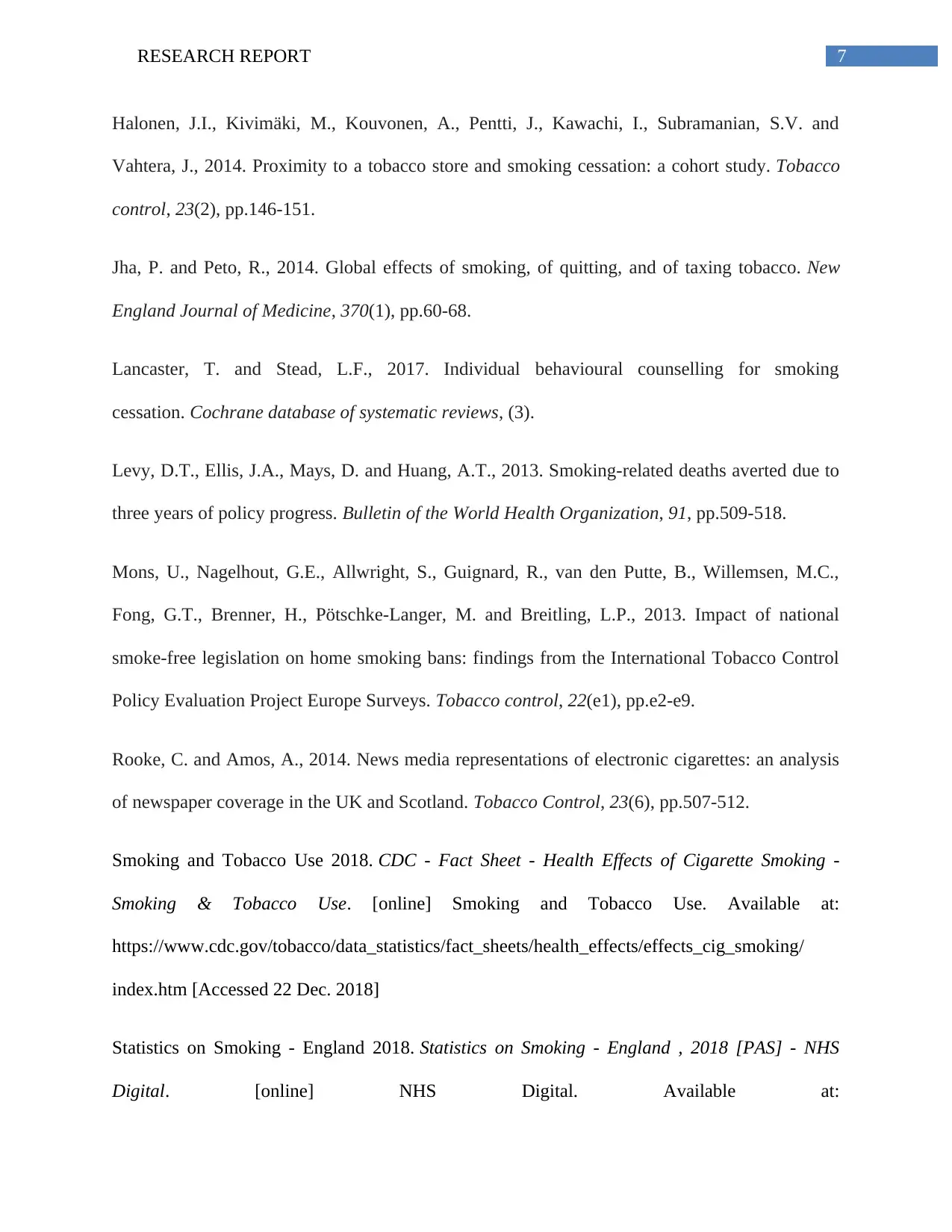
7RESEARCH REPORT
Halonen, J.I., Kivimäki, M., Kouvonen, A., Pentti, J., Kawachi, I., Subramanian, S.V. and
Vahtera, J., 2014. Proximity to a tobacco store and smoking cessation: a cohort study. Tobacco
control, 23(2), pp.146-151.
Jha, P. and Peto, R., 2014. Global effects of smoking, of quitting, and of taxing tobacco. New
England Journal of Medicine, 370(1), pp.60-68.
Lancaster, T. and Stead, L.F., 2017. Individual behavioural counselling for smoking
cessation. Cochrane database of systematic reviews, (3).
Levy, D.T., Ellis, J.A., Mays, D. and Huang, A.T., 2013. Smoking-related deaths averted due to
three years of policy progress. Bulletin of the World Health Organization, 91, pp.509-518.
Mons, U., Nagelhout, G.E., Allwright, S., Guignard, R., van den Putte, B., Willemsen, M.C.,
Fong, G.T., Brenner, H., Pötschke-Langer, M. and Breitling, L.P., 2013. Impact of national
smoke-free legislation on home smoking bans: findings from the International Tobacco Control
Policy Evaluation Project Europe Surveys. Tobacco control, 22(e1), pp.e2-e9.
Rooke, C. and Amos, A., 2014. News media representations of electronic cigarettes: an analysis
of newspaper coverage in the UK and Scotland. Tobacco Control, 23(6), pp.507-512.
Smoking and Tobacco Use 2018. CDC - Fact Sheet - Health Effects of Cigarette Smoking -
Smoking & Tobacco Use. [online] Smoking and Tobacco Use. Available at:
https://www.cdc.gov/tobacco/data_statistics/fact_sheets/health_effects/effects_cig_smoking/
index.htm [Accessed 22 Dec. 2018]
Statistics on Smoking - England 2018. Statistics on Smoking - England , 2018 [PAS] - NHS
Digital. [online] NHS Digital. Available at:
Halonen, J.I., Kivimäki, M., Kouvonen, A., Pentti, J., Kawachi, I., Subramanian, S.V. and
Vahtera, J., 2014. Proximity to a tobacco store and smoking cessation: a cohort study. Tobacco
control, 23(2), pp.146-151.
Jha, P. and Peto, R., 2014. Global effects of smoking, of quitting, and of taxing tobacco. New
England Journal of Medicine, 370(1), pp.60-68.
Lancaster, T. and Stead, L.F., 2017. Individual behavioural counselling for smoking
cessation. Cochrane database of systematic reviews, (3).
Levy, D.T., Ellis, J.A., Mays, D. and Huang, A.T., 2013. Smoking-related deaths averted due to
three years of policy progress. Bulletin of the World Health Organization, 91, pp.509-518.
Mons, U., Nagelhout, G.E., Allwright, S., Guignard, R., van den Putte, B., Willemsen, M.C.,
Fong, G.T., Brenner, H., Pötschke-Langer, M. and Breitling, L.P., 2013. Impact of national
smoke-free legislation on home smoking bans: findings from the International Tobacco Control
Policy Evaluation Project Europe Surveys. Tobacco control, 22(e1), pp.e2-e9.
Rooke, C. and Amos, A., 2014. News media representations of electronic cigarettes: an analysis
of newspaper coverage in the UK and Scotland. Tobacco Control, 23(6), pp.507-512.
Smoking and Tobacco Use 2018. CDC - Fact Sheet - Health Effects of Cigarette Smoking -
Smoking & Tobacco Use. [online] Smoking and Tobacco Use. Available at:
https://www.cdc.gov/tobacco/data_statistics/fact_sheets/health_effects/effects_cig_smoking/
index.htm [Accessed 22 Dec. 2018]
Statistics on Smoking - England 2018. Statistics on Smoking - England , 2018 [PAS] - NHS
Digital. [online] NHS Digital. Available at:

8RESEARCH REPORT
https://digital.nhs.uk/data-and-information/publications/statistical/statistics-on-smoking/
statistics-on-smoking-england-2018/content [Accessed 22 Dec. 2018].
West, R. and Shiffman, S., 2016. Fast facts: smoking cessation. Karger Medical and Scientific
Publishers.PP.111-115
https://digital.nhs.uk/data-and-information/publications/statistical/statistics-on-smoking/
statistics-on-smoking-england-2018/content [Accessed 22 Dec. 2018].
West, R. and Shiffman, S., 2016. Fast facts: smoking cessation. Karger Medical and Scientific
Publishers.PP.111-115
⊘ This is a preview!⊘
Do you want full access?
Subscribe today to unlock all pages.

Trusted by 1+ million students worldwide
1 out of 9
Related Documents
Your All-in-One AI-Powered Toolkit for Academic Success.
+13062052269
info@desklib.com
Available 24*7 on WhatsApp / Email
![[object Object]](/_next/static/media/star-bottom.7253800d.svg)
Unlock your academic potential
Copyright © 2020–2025 A2Z Services. All Rights Reserved. Developed and managed by ZUCOL.





